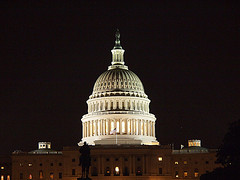
Budget battles leave a cloud over transportation funding as lame duck session looms

Same story, different year. Once again, we’re nearing the beginning of a new fiscal year on October 1, and Congress has failed to pass a budget to fund the government for the upcoming year. Even if Congress adopts a temporary budget to avert a shutdown —which is looking likely — important transportation programs could be left on hold on until lawmakers pass a full budget.
The House and the Senate never resolved their disagreement over the annual appropriations for transportation for the upcoming fiscal year — one of many budget issues that they couldn’t agree on this year. As in years past, the Senate provided more money for transportation programs in their appropriations bill than did the House. See the last column in the table below:
| FY14 USDOT actual | GROW AMERICA Act for FY15 (President's 4-year proposal) | HOUSE FY15 THUD Proposal ( & difference vs FY14 actual) | SENATE FY15 THUD Proposal (& difference vs FY14 actual) | DIFFERENCE between House & Senate FY15 proposals | |
|---|---|---|---|---|---|
| Federal-Aid Highways | $40.26B | $48.062B | $40.26B | $40.3B (+$40M than FY14) | +$40M in Senate proposal |
| Transit Formula Grants | $8.6B | $13.914B | $8.6B | $8.6B | - |
| Transit 'New & 'Small Starts' | $1.943B | $2.5B | $1.691B (-$252M than FY14) | $2.163B (+$220M than FY14) | +$472M in Senate proposal |
| TIGER | $600M | $1.25B | $100M (-$500M than FY14) | $550M -($50M than FY14) | +$450M in Senate proposal |
| Amtrak Operating | $340M | Proposes to roll passenger rail into two new programs that total $4.775 billion* | $340M | $340M | - |
| Amtrak Capital | $1.05B | same as above | $850M (-$200M than FY14) | $1.04B (-$10M than FY14) | +$190M in Senate proposal |
| High speed rail | $0 | same as above | $0 | $0 | - |
**The FY15 Administration Budget (Grow America Act) consolidates existing rail programs into 2 new programs (Rail Service Improvement Program and Current Passenger Rail Service).
With no progress made toward passing individual appropriations bills, or an “omnibus” that includes them all together in one package, Congress is moving on to temporary measures.
Yesterday, the House introduced a “continuing resolution” to extend government funding through mid-December that, if adopted, is expected to pass the Senate shortly afterward. That would ensure that the government can continue operating at the same funding levels as this past year. But it means that negotiations on a full budget will have to take place during the “lame duck” session, after the November elections but before losing members leave and new members arrive. That, or punt once again again until the new Congress starts in January.
With the elections likely to change the political landscape of Capitol Hill, it’s hard to predict what might happen after November 4th with any certainty.
In any case, as long as the government is operating via a short-term budget, any programs that are discretionary at USDOT (i.e., not funded from the Highway Trust Fund) will likely face great uncertainty. That means the next round of TIGER grants, money for new transit expansion (New and Small Starts), and passenger rail funding might see delays in when they’re awarded — creating even more funding uncertainty for states, metro areas and transit agencies.
At least the Highway Trust Fund is on stable footing until May, right, since Congress managed to scrounge up $10.8 billion through all manner of accounting gimmicks to temporarily delay insolvency?
Well, perhaps.
You might remember that about a year ago, USDOT was predicting that the trust fund would go bankrupt sometime late in 2014. Once we got into 2014, however, the deadline started shifting earlier. September. August. Then the end of July. So, in truth, who knows whether $10.8 billion actually will get us to May? It wouldn’t be too surprising to see a report from USDOT sometime in January or February, much as last time, saying that the trust fund is likely to reach insolvency a little sooner than previously thought.
One way or another, we’ll know more soon. Provided a shutdown is averted, members of Congress are scheduled to leave Washington after next week until the elections.



